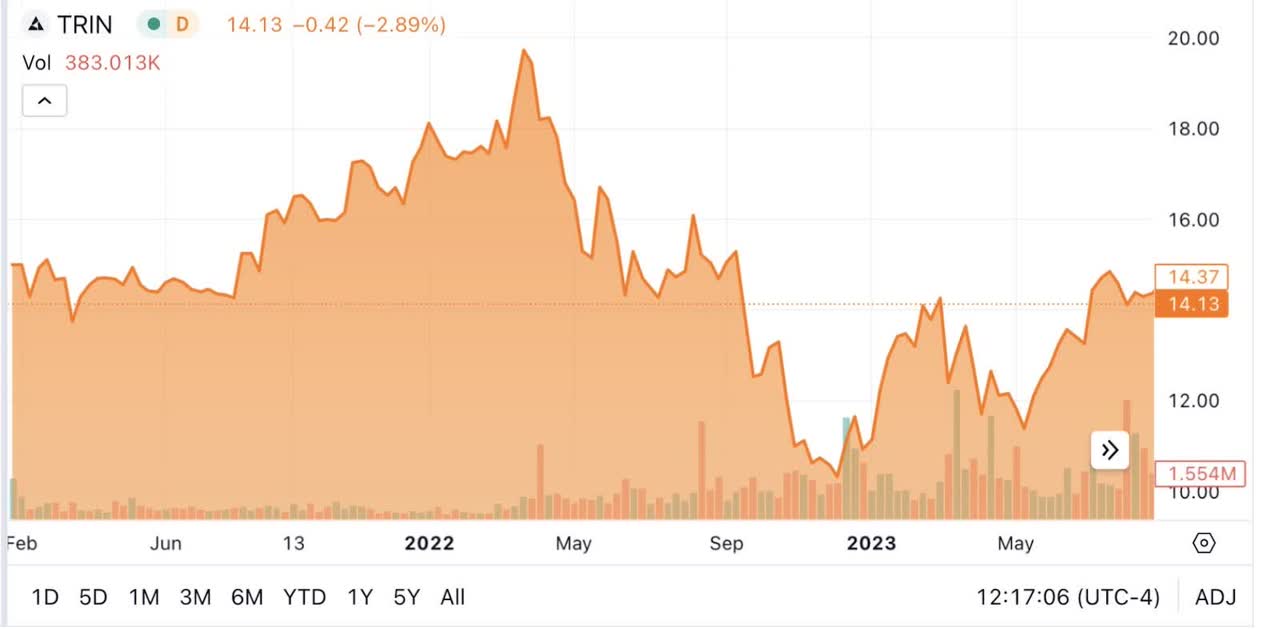Trinity Capital (NASDAQ:TRIN) is a business development company (BDC) formed in 2019 that provides loans to venture debt to growth stage companies looking for equipment financing and capital. One of the few internally managed BDCs, Trinity has benefitted from the bank volatility and increased need for additional sources of capital. As Trinity grows, we believe that it will benefit from economies of scale and improve earnings and fees. Trinity should continue to grow its assets and dividends, making it a good buy whenever it trades at a discount to NAV after it decides to issue additional shares. Earlier this year shares traded at a low of $10.06. Buyers at this level have received a 19% dividend and over 40% in capital gains. Although I would currently rate TRIN a hold, I would look for any opportunity to buy shares at or under $12. Long-term buyers and seekers of income might want to DRIP shares and rely on TRIN’s relatively small size to fuel future accretive growth. It is our belief that, over the long term, TRIN will benefit from its current size and be able to create deals that are more beneficial to shareholders than larger BDCs.
Seeking Alpha
Since its inception, TRIN has provided great returns on equity and numerous buy ratings from analysts including Jefferies, which is cited here, and Compass Point that noted accretive share offerings which you can read about here.
Earning Call Highlights
Strong Operating Performance: Trinity Capital Inc. had a strong operating performance in the first half of the year, with notable highlights including growth in net asset value (NAV), a substantial year-over-year improvement in net investment income (NII), and the 10th consecutive quarterly increase in their regular dividend.
NAV Stability: The stability of their portfolio, combined with accretive stock issuances, contributed to an increase in NAV to $13.15 per share in the second quarter. The company’s consistent track record of delivering solid returns and having a resilient portfolio even in a disrupted market is seen as a key factor in maintaining a stable NAV.
Dividend Growth and Coverage: Trinity Capital Inc. reported a net investment income of $22.1 million in the second quarter, equivalent to NII per share of $0.61, providing 127% coverage on their regular dividend. They recently increased their quarterly regular dividend to $0.48 per share, continuing their trend of dividend growth since their IPO. Additionally, they announced a supplemental dividend to comply with tax regulations, and they are evaluating their tax position for possible further supplemental dividends in the future. The company emphasizes its commitment to out-earning its regular dividend and seeking strategic investments to enhance shareholder returns.
High fees are a concern for any business, but in regards to TRIN, we believe the current high fees are being used to fuel future growth. Recent hires should be able to grow TRIN rapidly and help continue to fuel TRIN’s ROE efforts.
Key Hires
-
Rob Lake: Senior Managing Director with over two decades of experience in the life science sector.
-
Igor DaCruz: Managing Director with more than 12 years of experience in the industry.
-
Andrew Ghannam: Managing Director based in Manhattan, with over a decade of experience in lending to venture-backed technology companies.
These hires strengthen Trinity Capital Inc.’s expertise, geographic diversity, and presence in the life science and tech lending sectors, supporting their strategic expansion in these key markets.
Key Growth Drivers
- Strong Investment Environment: The venture capital (VC) industry is in a solid position, with record levels of dry powder in the U.S. estimated at over half a trillion dollars. In the second quarter, total VC industry investments reached $40 billion, surpassing pre-2021 levels. While some portfolio companies are receiving financing at lower valuations, equity support at any valuation is considered positive for Trinity Capital Inc.
- Focus on Debt Financing: Trinity Capital Inc. emphasizes the importance of debt financing as a crucial solution for venture-backed companies looking to fund growth without significant dilution. They see their role as providing financing options in an evolving competitive landscape, particularly in the context of volatility in the banking industry.
- Expansion in Life Science and Tech Lending: Trinity Capital Inc. is actively expanding its presence in the life science sector, with a growing portfolio dedicated to life science investments exceeding $100 million. They have appointed experienced professionals and established a new office in San Diego, a major life science hub. Additionally, they are expanding their tech lending platform’s presence on the East Coast, particularly in New York. The company is building a unique internally managed BDC platform, engaging potential investment partners for their RIA, and intends to ramp up off balance sheet activity to benefit shareholders. Their robust pipeline and diversified portfolio position them for growth in the second half of the year.
Analysis
Trinity’s first-half performance is noteworthy, marked by a 41% YoY improvement in net asset value (NAV), a significant increase in net investment income, and the 10th consecutive quarterly dividend hike. This indicates operational consistency and disciplined growth.
Trinity operates in a venture capital market that’s adjusting to post-banking crisis disruptions. Despite economic volatility, the VC industry in the U.S. is well-funded, with an estimated half a trillion dollars of dry powder. This suggests a favorable environment for alternative lending solutions.
Trinity’s investment activity in Q2, with $40 billion in total VC industry investments, surpassing pre-2021 levels, is a positive sign. Despite some portfolio companies receiving lower valuations, the influx of equity funding into 30 of Trinity’s portfolio companies totaling $1.4 billion YTD shows investor confidence in their selection.
Trinity’s role in providing debt financing to venture-backed firms seeking growth without excessive dilution is a strategic niche in the market. In a climate where funding options may be limited, Trinity’s offerings serve as a crucial solution.
Trinity benefits from a favorable competitive landscape. Volatility in traditional banking has created opportunities for non-bank lending solutions like Trinity. Although the pipeline has expanded, a rigorous underwriting process remains intact, indicating a commitment to risk management.
Trinity is actively pursuing a growth strategy, with a particular focus on the life science sector. The appointment of experienced professionals, the growth of life science investments to over $100 million, and the opening of a strategic office in San Diego demonstrate a commitment to seizing opportunities in this field.
Trinity’s expansion of its tech lending platform on the East Coast, particularly in New York, positions the company in a key market for future growth. The addition of Andrew Ghannam, with his extensive experience in lending to tech companies, reinforces Trinity’s capabilities in this region.
Trinity’s off balance sheet growth, facilitated by a credit facility with KeyBank, adds incremental returns. These returns enhance value for shareholders, and Trinity aims to ramp up off balance sheet activities to further benefit investors.
Trinity’s portfolio remains diversified across 19 different industries, with no single industry representing more than 12% of the portfolio at cost. This diversification mitigates sector-specific risks.
The company finished the quarter with $345 million of unfunded commitments, subject to milestones and ongoing diligence. This provides future growth potential and indicates a robust pipeline.
Trinity anticipates that companies will continue to seek alternative lending solutions in the second half of the year. Their aim is to be the preferred lender for growth-stage companies. As an internally managed BDC, their focus is on generating returns on equity and delivering steady dividends to shareholders.
Trinity seeks to diversify its capital base further, accessing both public and private markets to enhance returns for shareholders.
Risks
Trinity Capital Inc. must grapple with an assortment of risks that loom large in this volatile terrain. As the company extends debt financing to budding ventures, leaving it vulnerable to defaults in an uncertain market poses credit risk. Market fluctuations also weigh heavily on Trinity’s investments and returns, influenced by factors like interest rates and venture capital availability. Liquidity risk arises, with the potential for challenges in liquidating assets when needed, complicating cash flow management. Interest rate risk, a specter for all financial institutions, is a constant concern, while formidable competition from traditional banks, fellow BDCs, and alternative lending platforms adds to the complexity. The performance of portfolio companies, a vital income source, and regulatory and compliance risks further compound the challenges Trinity faces. Economic downturns, market volatility, and geopolitical events cast a shadow, and Trinity’s growth prospects hinge on successfully executing exits for its portfolio companies. Government regulation also looms on the horizon. As an internally managed BDC, the company’s ability to mitigate these risks will shape its success in generating returns for shareholders.
Final Thoughts
Trinity Capital Inc. stands at the intersection of financial innovation and venture capital, armed with both promise and peril. As a relatively small BDC in the ever-evolving world of debt financing, Trinity has achieved commendable growth and strategic diversification, capitalizing on opportunities in sectors like life sciences and technology. Navigating credit risk, market volatility, and competitive pressures requires both finesse and vigilance. Trinity’s commitment to prudent risk management, regulatory compliance, and seizing growth opportunities off balance sheet exemplify its ambition to maximize returns for its shareholders. In an environment marked by uncertainty and dynamism, Trinity’s journey underscores the resilience and adaptability necessary for success in the realm of venture capital. Investors and industry observers alike would be wise to keep a watchful eye on Trinity Capital as it continues to write its unique story in the years ahead. We will be looking for opportunities to add Trinity Capital to our portfolio and although we rate it a current hold, we think that future opportunities to buy shares at a discount will present themselves due to volatility and its small size. We would be happy to add shares at prices at or under $12. As always please do your own due diligence before buying any equity and if you like the article please give me a like and a follow. Good luck investing.
Read the full article here















